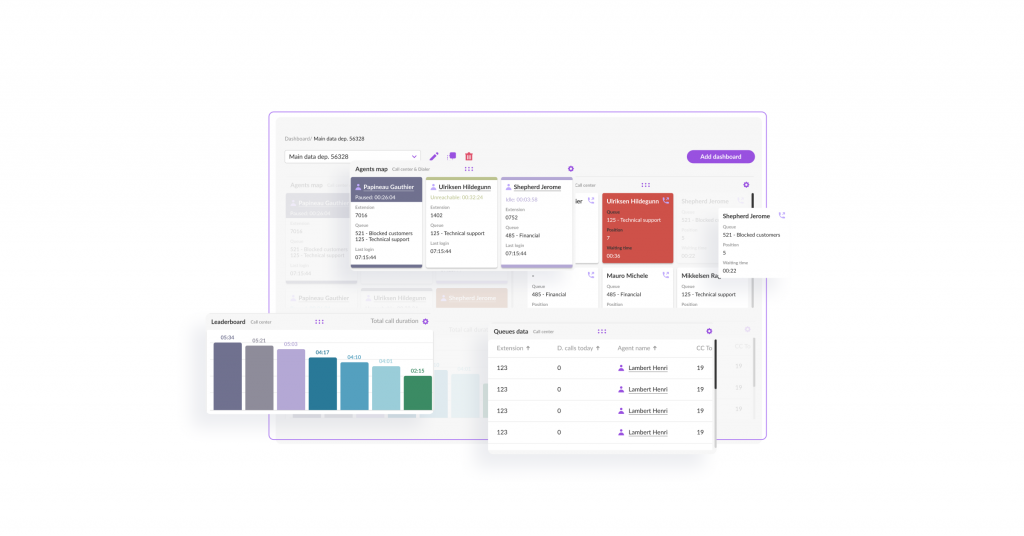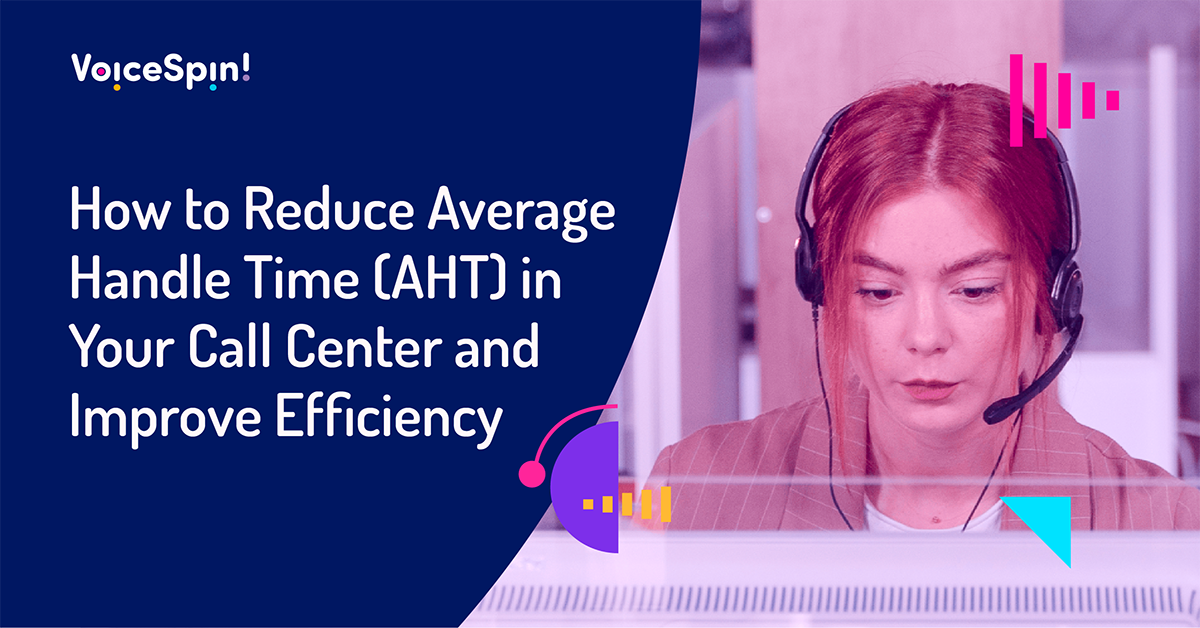Today’s consumers increasingly demand high levels of customer service and support delivered to them and want their issues resolved quickly and efficiently. To ensure that, call center agents must be able to provide quick answers and resolutions to customer queries regardless of their complexity. That is why the Average Handle Time (AHT) is a critical KPI for contact centers. In this article, we’ll break down the Average Handle Time definition, how to calculate AHT, why it’s an important metric, and ways to reduce AHT in your call center.
What is Average Handle Time in Call Centers?
Average Handle Time, also referred to as Average Handling Time (AHT), is a widely used call center metric that measures the average amount of time a customer service representative spends on a call with the customer from start to finish. That includes the actual conversations, hold times, transfer times, and any necessary call follow-up activities. Though AHT typically refers to service phone calls, it can also be measured across all channels in a multichannel contact center.
The average industry standard for AHT is slightly over 6 minutes, yet, that number may greatly vary based on the sector, the scale of a business, the complexity of the products and services provided, and other factors. As a general rule of thumb, you should be aiming to reduce your AHT to improve your agent performance, enhance customer satisfaction and overall customer service quality, and cut down on your call center costs.
How to Calculate Average Handle Time
As already mentioned, AHT can be measured for different channels, including email and chat support. The standard Average Handle Time formula is simple: you need to divide the total handling time by the total number of calls (emails/ chats). The total handling time includes the talk time, hold time, and after-call work. AHT can be measured per agent, per department, or across the entire contact center.
AHT = (Total Talk Time + Total Hold Time + After-Call Work)/ Total number of Calls
- Talk time: the time a call center agent spends speaking with customers.
- Hold Time: the time a customer spends on hold during the call, initiated by an agent (may also include transfer time).
- After-Call Work (ACW): the time spent by an agent on follow-up tasks after completing the call, such as taking notes, updating the CRM records, logging the call outcome, scheduling follow-ups, etc.
Why is AHT Important in Call Centers?
AHT is one of the most critical call center metrics to pay attention to. Along with other important metrics and KPIs, such as First Call Resolution, Call Abandonment Rate, Customer Satisfaction Score, and Customer Effort Score, AHT is a key indicator of how efficiently agents handle customer inquiries and whether they are able to maintain quality customer service.
A high AHT may indicate an inefficient call routing strategy or poorly trained agents. By consistently monitoring AHT, call centers can uncover inefficiencies in customer service processes, identify areas for improvement, and determine where agents require additional training and call coaching.
Benefits of Reduced Average Handle Time
Though a short Average Handle Time is a desired scenario for most call centers, it’s equally important to keep the right balance between handling customer issues quickly and providing excellent service. Reducing AHT without compromising the service quality has been a big challenge for call center managers. Despite that, lowering the Average Handle Time can bring in some significant benefits:
- Improved customer experience
When customers reach out to your support team, chances are they’ve already tried to get answers to their questions and resolve issues on their own through your self-service options. That is why they expect quick and efficient support, and they definitely don’t want to waste their time. Reduced AHT means faster resolutions, increased FCR and customer satisfaction, happier customers, and improved overall customer experience.
- Increased efficiency and cost savings
Reduced Average Handle Time means agents generally spend less time on each call – so they can handle more customer calls within the same amount of time. That leads to increased agent efficiency and productivity and more efficient use of call center resources. In terms of cost savings, lowered AHT results in lower costs per call, reduced agent training costs, and no need to allocate additional staff to handle the same call volume.
How to Reduce AHT in a Call Center: 5 Tips and Best Practices

How to improve AHT in a call center and ensure agents maintain low AHT while delivering a high-quality service experience to your customers? Below are some of the most proven ways to reduce the Average Handle Time in a call center and improve its overall efficiency:
1. Ensure an efficient call routing strategy
HubSpot research found that 33% of customers are most frustrated by having to repeat themselves to multiple support representatives. A well-implemented Interactive Voice Response (IVR) system can reduce the Average Handle Time since it enables customers to get answers without having to talk to an agent or connect to the right call center reps by following menu prompts or interacting with voice bots.
Having a well-thought-out call routing strategy can also significantly add to improving AHT. For example, with skill-based routing, your incoming calls will be assigned to the most appropriate agents based on their specific skill set and expertise. That ensures each customer call is handled by the best-suited agent, who is equipped with the right knowledge to deal with this type of inquiry, which reduces the time required to resolve issues.
2. Leverage call recording and call monitoring
Call recording is one of the most helpful call center software features for inbound call center teams. Luckily, most call center software providers offer the ability to record and store customer calls, which can then be easily accessed by managers, supervisors, or agents. By consistently analyzing call recordings, you can spot inefficiencies in your processes, identify bottlenecks, and make the necessary changes to improve the flow of incoming calls and reduce the Average Handle Time.
Real-time call monitoring is another essential feature of call center tools that can take your team’s performance to a whole new level and shorten AHT while also improving customer satisfaction. It enables supervisors to listen in on live calls, provide instant, real-time feedback, and assist a struggling agent through call whispering and call barging capabilities. That helps agents handle calls more efficiently and reduces AHT.
3. Optimize your agent onboarding and training
Consistently monitoring agent calls can also help managers identify agents’ knowledge gaps and lacking skills to adjust and improve the onboarding and agent training process. When agents are highly knowledgeable about your products and services, they won’t have to spend time looking up answers during customer interactions.
On top of that, if they are well trained in the most critical soft skills, such as effective communication, empathetic listening, problem-solving, conflict-resolution, and call-handling techniques – they can resolve issues quickly and more efficiently, with a shorter handling time required.
Besides, regularly collecting customer feedback can give you valuable insights into the most common issues, leading to longer call handle times. Armed with the right data, you can improve your agent training and coaching strategy and work out the best practices for agents to follow.
4. Empower agents with well-structured scripts
Though using call center scripts is often associated with a robotic and ‘one-size-fits-all’ support approach, that isn’t entirely true. In fact, call center scripts and templates are extremely valuable tools helping agents provide accurate and relevant information to customers and deliver a consistent service experience with every interaction. With well-structured scripts at hand, agents can provide faster answers (especially to complex questions) without having to craft a response from scratch every time.
That said, blindly following ready-made scripts each and every time isn’t always the best option. Agents should also be empowered and encouraged to go off the script and be flexible whenever appropriate to deliver personalized experiences that are much appreciated by today’s consumers.
5. Build a knowledge base and self-service options
Having a knowledge base and other self-service options can help call centers reduce AHT in two ways. Firstly, when customers are provided with various self-service tools, they can find answers to their questions and resolve issues without having to contact your reps, which can reduce your overall incoming call volume. Research found that 79% of consumers expect organizations to provide self-support tools, while 84% say they try to solve support issues before they reach out to agents.
Secondly, a comprehensive knowledge base isn’t only good for your customers. You can also create an internal knowledge base with helpful guides and cheat sheets that will only be available to your support team. This is especially handy for newly-hired and inexperienced agents, who can use it to quickly locate answers, reducing the Average Handle Time.
Maintain a Low AHT by Combining Training and Technology

The key to maintaining a low Average Handle Time at your call center is combining efficient agent training practices and call center technology with the right set of features and capabilities, enabling agents to handle customer issues quickly and efficiently. Book a personal demo to learn how VoiceSpin’s call center software solution can help your team enhance efficiency, improve the Average Handle Time and other critical call center metrics, and optimize your overall call center operations and performance.
FAQs
What is considered a ‘good’ Average Handle Time?
The AHT benchmark significantly varies from industry to industry. A ‘good’ Average Handle Time can range from less than a minute to several minutes, based on the industry average. It also depends on the nature of the calls your agents typically deal with. E.g., a tech support center that handles complex technical issues may have a higher AHT compared to a call center that handles simple informational requests. As a general rule, a lower AHT (below your industry average) is usually considered better, as it indicates your agents are handling customer calls quickly and efficiently.
What are the most common reasons for a high AHT?
One of the most common reasons for a high AHT is a poorly implemented call routing strategy, which may result in more call transfers or agents spending more time resolving issues that are not within their area of expertise. Lack of streamlined processes, outdated call center technology, and inefficient agent training may also lead to higher Average Handle Time. In addition, agents may not have instant access to all the necessary knowledge base resources to resolve issues quickly and efficiently.





 +18889082995
+18889082995
 +442036084160
+442036084160
 +97237237006
+97237237006